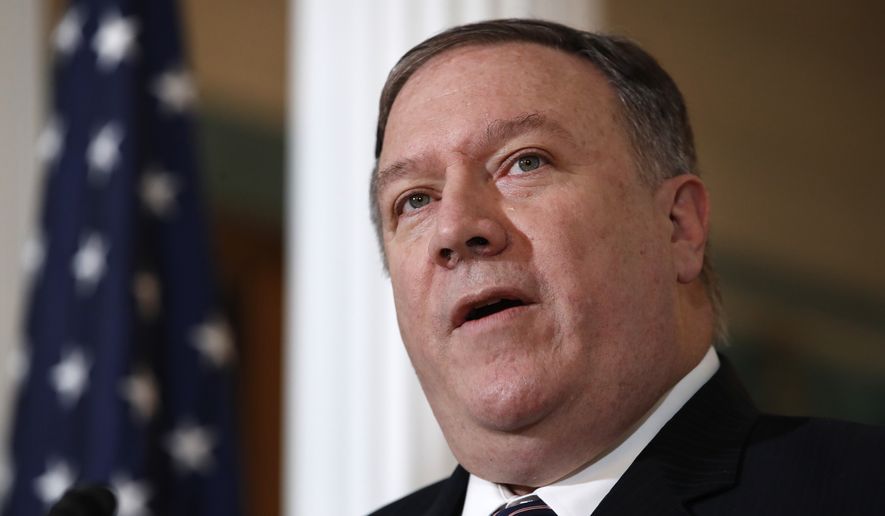The Trump administration said it will admit no more than 30,000 refugees next year, the lowest cap in history, making good on a presidential promise and enraging immigrant rights activists, who said the U.S. is shirking its global duty.
Secretary of State Mike Pompeo cast the level — one-third lower than the 2018 ceiling — as a needed pause while the country gains a handle on security risks and deals with some 800,000 people already in the U.S. with pending asylum cases.
“The ultimate goal is the best possible care and safety of these people in need, and our approach is designed to achieve this noble objective,” Mr. Pompeo said.
The 30,000 level is only a ceiling, and the actual number could go even lower. Indeed, this year’s cap is 45,000, but with just weeks to go before the end of the fiscal year, the government is on pace to accept less than half that number.
Critics including refugee advocates and congressional Democrats have called this year’s pace abominable and were dismayed with next year’s number. They said it’s a major retreat from the Obama era, when the State Department set a 110,000 ceiling for the final year.
“Quite simply, this decision will lead to innocent people dying,” said Rep. Eliot L. Engel of New York, the top Democrat on the House Foreign Affairs Committee. He described the decision as “a heartless betrayal of American values.”
Activists said the decision is particularly troubling given the scope of international need. The United Nations categorizes more than 25 million people as refugees.
“This decision is not informed by the global need, nor by America’s national security and foreign policy priorities. And it will not only harm refugees, whose lives are at risk, but also America’s interests abroad and at home,” said Betsy Fisher, policy director at the International Refugee Assistance Project.
Accepting refugees has been deeply controversial in the U.S. President Obama’s move to raise the cap in his final years drew a feverish backlash from security analysts and was part of the impetus for President Trump’s campaign promise of a travel ban.
American officials say criticism of the U.S. is based in part on a game of semantics.
Other countries term all foreigners seeking humanitarian protections to be refugees, but the U.S. breaks them down into two categories. Refugees are those who apply from outside the U.S., and asylum-seekers are refugees who manage to reach American soil and then apply.
When viewed that way, the U.S. will accept 280,000 asylum-seekers next year in addition to the 30,000 refugees, Mr. Pompeo said.
He said the U.S. is already struggling with 800,000 asylum petitions pending in the system. The backlog was built up as a surge of people from Central America lodged asylum claims. In previous years, they would have been classified as illegal immigrants and quickly deported.
When refugees and asylum-seekers are counted together, Mr. Pompeo said, the U.S. is “the most generous nation in the world.” He said hundreds of thousands of people granted Temporary Protected Status while their countries recover from earthquakes, hurricanes, war or disease should be counted as part of America’s humanitarian efforts.
“Some will characterize the refugee ceiling as the sole barometer of America’s commitment to vulnerable people around the world. This would be wrong,” he said.
The refugee program came under intense scrutiny in the final years of the last administration, particularly after Mr. Obama said the U.S. would start taking more people from Syria amid that country’s civil war and threats from the Islamic State.
Defenders of refugees say they are the most vetted of any foreigners the U.S. admits.
But security analysts said there was no way to be sure of the identity of people attempting to enter from places such as Syria, where the U.S. didn’t get cooperation from the government and where the chaos made it impossible to check back stories.
In Mr. Obama’s final full year overseeing refugees, the U.S. took in more than 12,000 from Syria and nearly 10,000 more from Iraq.
In the current fiscal year, the U.S. has admitted just 60 from Syria and 132 from Iraq.
Mr. Pompeo, in announcing the lower refugee numbers Monday, pointed to security concerns.
He said one person with ties to the Islamic State managed to sneak in as a refugee from Iraq. Other refugees have managed to conceal criminal backgrounds in their refugee cases, he said.
“The American people must have complete confidence that everyone granted resettlement in our country is thoroughly vetted. The security checks take time, but they’re critical,” the secretary said.
• Stephen Dinan can be reached at sdinan@washingtontimes.com.




Please read our comment policy before commenting.